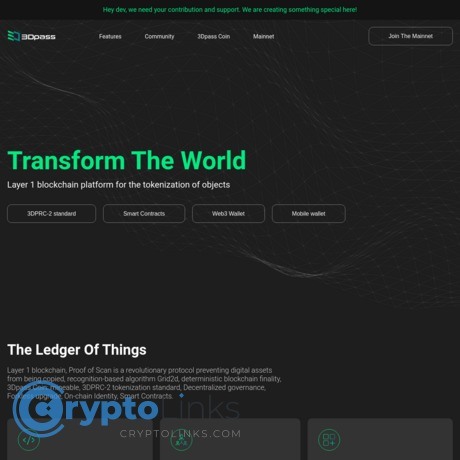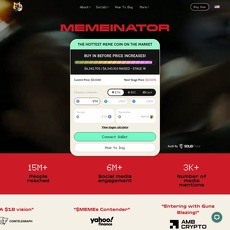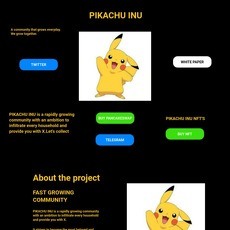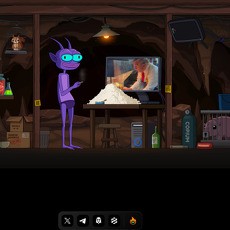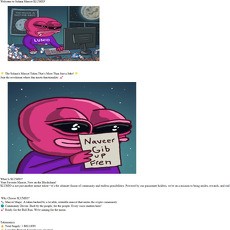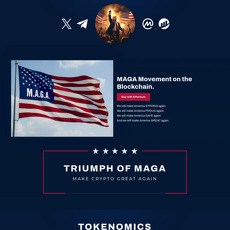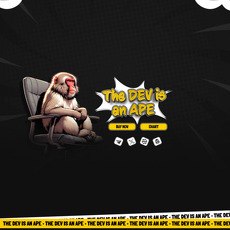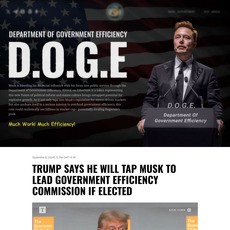3DPass Review
3DPass
3dpass.org
If your website is on the scam list and you think that you are not a scammer, contact us. After you provide us with all the proof that you are in Crypto World with good intentions, we will delist you. Usually, you get in this category because you are hiding your team, you have a bad reputation(you are tricking, deceiving, scamming people), and you haven't got a written project whitepaper or is a shitty one....
Their Official site text:
Hey dev, we need your contribution and support. We are creating something special here!
FeaturesCommunity3Dpass CoinMainnet
Features
Community
3DPass Coin
Mainnet
Join The Mainnet
Features
The Object Recognition
Hash ID
The Object Categories
Multi-Object Option
Proof of Scan Protocol
Block production (Mining)
Object authenticity and block verification
Deterministic blockchain finality
The Ledger of Things
3DPRC-2 standard
Overview
Implementation
Fungible and Non-fungible backed assets
Asset management
Fungible assets
Smart Contracts
Atomic Swap
Embedded DEX
The Tokenization of 3D Objects
Password and Keys Creation
Integration
The Object Recognition
In the foundation of 3Dpass lies the object recognition open source technology presented as a stuctured set of fundamental-research-based algorithms created by either the team or community members.
The algorithms are especially adapted to operate within the blockchain inviroment, which doesn't provide any feedback to compare objects to one another while its processing. Essentially, it is caused by the absence of trustworthy backend in the blockchain architecture, which implies a number of equal nodes to be admininstrated by users not providing substantial trust towards each other. Thus, any object, event or transaction must rather be proved by math calculations performing off-line.
The first algorithm Grid2d, suggested by Michael Co in 2020, is designed for 3D object shape recognition, however, the scope of potential 3Dpass applications goes way beyond that and not limited to. The algorithms implementation is available as pass3d recognition toolkit, which plays essential role in the Proof of Scan consensus protocol operating on the The Ledger of Things blockchain.
Hash ID
pass3d recognition toolkit captures some distinctive properties of the object and produces its digital identity called HASH ID, which will remain stable for every different scan taken out of the same object. The HASH ID allows to establish one-to-one correspondence between the object and its digital asset, which any conventional NFT could never sustain Learn the difference.
HASH ID provides excellent level of privacy containing "0 knowlege" about the object itself. The original data (seed) is protected by cryptographic standard SHA-256.
HASH ID allows to define the property rights as being distinguishable to the extent of the error of recognition. Meaning, original assets could be distinguished from fakes and, thus, protected from being copied.
img
Mobile WalletDownload
The Object Categories
3DPass is called to encourage developers to upgrade the pass3d open source toolkit with new fascinating recognition algorithms and add to its usefulness for people. In order to simplify the challenge we have put it into some structure, which makes it easy for machines to understand on input. Learn more about the algorithm requirements.
This is apparent, that it does not make sense to compare objects by its HASH ID, provided they got processed with different recognition algorithms/parameters. However, HASH IDs need to be compared with one another in order to guarantee for users the absence of copies on the blockchain data base.
By means of categorization of the object types, we are setting up some “standard” algorithms (presets) to be available to use within each category. And the level of precision is being determined by every preset, at which the object is going to be recognized. Learn more about 3DPRC-2 tokenization standard implementation.
Initial list of categories is presented as follows:
3D objects
Algo: grid2d_v3a -s 12 -g 8 (learn more about Grid2d)
2D drawings
Music
Biometrics
Radio signals
Movements
Texts
Feel free to implement or suggest new algorithm for any category above and jump right in 3DPass contribution rewards program
Multi-Object Option
Not only could single object have been used for the (HASH ID) creation, but also a combination of several ones instead. For example, the object shape, combined with its additional properties (size, weight, density, clarity, owner's biometric data, etc.), or just a bunch of different-shaped 3D objects might be chosen. This complex HASH ID, calculated out of multi-seed, becomes much more secure against the attack, due to the multi-factor authentication. It might, as well, help us capture a few different properties inherent to the object. Let's consider these examples:
Piece of rock + Owner's fingerprint - HASH-ID 1
3D object shape + Its weight - Hash-ID 2
Object_1 shape + Object_2 shape - Hash-ID 3
img
In the example above:
3D Object is "something that you have" factor
Fingerprint is "something that you are" factor
PIN code or password or special movement or what so ever might be added as "something that you know" factor as well.
Proof Of Scan Protocol
Proof of Scan is a revolutionary decentralized protocol, which is leveraged not only as 3Dpass blockchain network consensus, but also designed to prevent digital assets from copying. All of those assets present nothing, but endless of kinds of objects tokenized, such as: 3D objects, 2D drawings, melodies, voices, radio signals, and so on. Due to the recognition technology the protocol is based on, this novel approach unfolds the access to potential trillions in deals all over the globe.
"One object = One asset" rule
The first and the most important PoScan (Proof of Scan) rule states "1 object = 1 asset", which refers to the recognition algorithm being used instead of some usual hash function like SHA256. As such, Grid2d algorithm is leveraged for 3D object recognition in 3Dpass.
img
Block Production (Mining)
3Dpass exploits PoW (Proof of Work) concept for the block production, due to the fact that the recognition always takes computing power for the objects to get veryfied. In Proof of Scan 3D object ( in obj. format) is used as a "nonce". And so, miners are picking up a unique-shaped 3D object the HASH ID of which, being sealed to the parent block hash with SHA256, would make Grid2d recognition algorithm produce a specific output ( the hash value below the limit called "Difficulty") like 000000...". Learn >> how to mine 3Dpass coin
Object Authenticity And Block Verification
The network will always agree upon the state of whether or not each one object tokenized is considered to be original. It serves as an object authentication service provided by one layer of equal nodes.
Use 3Dpass mobile wallet to verify Proof of Scan to work.
img
Deterministic Blockchain Finality
Proof of Scan implementation is equipped with GRANDPA finality gadget which is guaranteed for blocks to reach finality in opposite to probabilistic finality (e.x. Nakamoto protocol which first was applied in Bitcoin). PoA (Proof of Authority) concept is being used for block finalization. There is an Authority set called Validators consisting of the most reliable nodes thoroughly selected from miners. They vote upon Best chain and, after the voting is complete, there is going to be no chance for the finalized chain to get reorganized (2/3 + 1 positive votes is enough to make the final decision)
img
Read this article to learn more about how Proof of Scan could be compared to conventional PoW (Proof of Work). Follow either the full protocol description or White paper to get some detailed information.
The Ledger Of Things
3DPass decentralized p2p platform represents Layer 1 blockchain, the Nodes of which will prevent assets form copying, even if you change its model with one dot, pixel or one byte. We call it "The Ledger of Unique Things".
img
The platform provides the ability to develop the endless of useful smart contracts and dApps the logic of which would be tightly tethered to something we use in life. Every object, transformed by 3Dpass, acquires its own unique and sustainable identity called HASH ID which serves to be as 1:1 correspondence between the object and its asset.
Useful Links:
The Network NODE
Development Wiki
3DPRC-2 tokenization API
Network telemetry server
Block explorer
Block data graphql API
3Dpass Web3 wallet | polkadot js wallet
How to start mining
How to become Validator
Smart contracts trait leveraging ink, a Rust-based embedded domain specific language (eDSL) for writing WebAssembly smart contracts.
Governance and forkless upgrade, On-chain Identity
Substrate-based and scalable solution: IPFS storage, Smart contracts, etc. Learn more about 3Dpass network NODE integration.
MainnetJoin the Network
3DPRC-2 the object tokenizaton standard
Overview
3DPRC-2 (3Dpass Request for Comments), proposed by PaulS in September 2023, is a standard p2p protocol for the tokenization of the user objects operating within “The Ledger of Things”. Its implementation represents one of the most useful aspects of "Proof of Scan" consensus, which opens the capability for the network to provide the tokenization service to customer.
Learn the difference between the revolutionary 3DPRC-2 tokenizaton standard based on the object recognition and conventional ERC-721 for NFT using just an account signature:
Put your object on The Ledger of ThingsPut the object
3DPRC-2 implementation:
Advanced version of Proof of Scan- The protocol is weaved into “The Ledger of Things” PoW component in a way to tackle the user objects authentication along with the ones being mined. The protocol ensures for users to get a complete service always resulting as either the object acceptance (the asset is allowed to be created) or its rejection (copy is found on the db). The network is responsible for the user object authentication as much as for any block on the blockchain irrespective to the actual dollar value attached to
“0 knowledge proof”- Every judgement provided by miners about the object authenticity is protected by a secret knowledge of its HASH ID being unavailable for them, until they get the object processed. Every proof is being verified by the majority of the network to make a final decision on whether to accept or reject the block containing the judgement
PoScan pallet and poscanAssets module (storage and API) - The PoScan pallet as well as the poscanAssets module are both integrated into the network runtime providing the access to the network decentralized storage by means of the object tokenization API, which allows for:
the user object authentication and its protection from being copied to the extent for the recognition algorithm precision;
non-fungible backed asset creation;
property rights definition and its transfers;
backed cryptocurrency issuance (the tokenizaton of the object share)
collective asset management
Fungible and Non-fungible backed assets
By means of dealing with the additional properties 3DPRC-2 makes it possible to tokenize the object into either Fungible or Non-fungible asset, depending on the purpose of its tokenization. And only one of its properties could have been tokenized simultaneously. It is prohibited to have multiple properties tokenized at the time (It's not allowed to sell one object twice).
Thus, the tokenization of the object Share, as well as such properties as: Weight, Square, Volume, Length, etc, will always stand for its collective ownership or ICO (Initial Coin Offering). These properties will be tokenized as Fungible assets, the MaxSupply of which is limited to the property value attached to the object. For example, if the object weight is 1000 gram, then the "MaxSupply=1000" limit will be set up for the token created (you won't be able to issue more than 1000 minimum indivisible units). While transferring tokens, the object share ownership is being transferred accordingly.
Get the object share tokenizedTokenize
3DPRC-2 allows to tokenize every single object into the Non-Fungible asset. If chosen, the "MaxSupply = 1" limit will be applied to the token created. Whereas "1" is the minimum indivisible unit of The Ledger of Things. By means of transferring this unit, the ownership of the entire object is being transferred.
Turn the object into non-fungible assetTokenize
Collective asset management
The asset management system is designed for its shareholders to manage the asset via democracy vote.
Fungible assets
"The Ledger of Things" is equipped with the poscanAssets module providing some useful methods for dealing with simple fungible assets without a necessity to run a smart contract.
Regular fungible assetCreate
Smart Contracts
Substrate Smart contract trait using ink, a Rust-based embedded domain specific language (eDSL) for writing WebAssembly smart contracts. Learn more about how could that be compared to Solidity. Follow the guiudelines to run your smart contract on 3Dpsass.
Coming soon! EVM emulator pallet, which allows for unmodified EVM code to be executed on 3Dpass blockchain. This feature is designed to closely emulate the functionality of executing contracts on the Ethereum mainnet within 3Dpass network.
Smart contractRun
Atomic Swap
Atomic Swap Substrate module providing the option of making safely and the time-proof-based p2p swap between two given assets issued on The Ledger of Things. In order to recieve some funds, atomically sent from one account to another, the "claim" transaction must be initiated by the target account. If the swap has still not been claimed during the timeframe limit, it will then be available to cancel by its sender.
Embedded DEX module
The assetConversion Substrate module representing a full featured decentralized exchange, based on Uniswap v2 protocol rules, integrated into The Ledger of Things runtime. Enjoy the DEX API on Github, create Liquidity Pools and trade the assets issued on The Ledger of Things.
The Tokenization Of Real And Virtual 3D Objects
The only difference between tokenization process of either real or virtual 3D objects is the way you are getting seed data to create HASH ID out of. Dealing with virtual ones, there is no problem to get 3D model and other properties, since they are initially digital. Howener, seed data extraction out of real 3D objects takes efforts and is not always possible because of nowadays limited technological capabilities. On top of it, the utilization of tokens, produced out of virtual objects, might be the way different due to the "virtual" material they are created from. There is no fungibility restrictions, no proof of exisctence problems, etc.
Tokenization Of Real World Objects
Using a smartphone camera or professional scanners and lab measurements (depends on how much precision do you need), you can extract some seed data from a real 3D object which is, basically, a 3D scan ( .stl or .obj standards are supported). And then, by means of using pass3d recognition toolkit, you can produce its HASH ID, as long as the object has a solid shape. Flexible ones won't work because their shape is unstable and might not be recognized by 3Dpass. However, there is a possibility to tokenize a 3D model of flexible things (ex. clothes) in one state (ex. a t-shirt put on a mannequin) and then use it as the standard for Machine Learning recognition.
For example, you can tokenize a rough diamond and then divide it by carats in digital and trade the carats on the market. And if you put in an owner's fingerprint and create a complex HASH ID from both the fingetprint and the diamond's properties (shape, weight, clarity, etc), then you'll have a personal digital asset. Now, not only the diamond is able to recognize but also its owner, so all the property rights might be followed.
However, all the initial seed data of the asset remains private, unless the owner would reveal it themself (in the case described above it's original data of both fingerprint and the diamond shape + its additional properties). It's "hidden behind the HASH ID" which is suppose to be public since it's strong enough to stand against the attack attempting to reconstruct the seed data. At least, the HASH ID is protected by multi-factor authentication:
Tokenization of virtual objects
As it was mentioned above, there is no problem to extract seed data if you are dealing with virtual 3D objects. All you need to do is to get 3D model (.stl or .obj) + additional property values and process them via 3Dpass recognition toolkit. After HASH ID is produced, there is no restrictions related to physical object. Therefore, you can use your asset what eveter you like, although it would've never been possible to do the same in real world.
For example, you can tokenize a virtual diamond and then leverage it as a fungible token or you can get it melted within the virtual space such as: metaverse, augmented reality, gaming, etc.
Tokenization Of The Object Shape Changes (in dynamic)
One of the most important options to acknowledge about tokenization is that you can capture the object shape changes in dynamic. Not only static option is avalable. Let's imagine the case of a car accident. A car had its original 3D shape and then it was damaged, although the asset is still the same. The car's owner has not been changed as well. Assuming the car had its HASH ID saved on 3Dpass dezentralized ledger before the accident, the owner can create a new HASH ID and link it to the former one in the transaction. As a result we have a sequence of assets linked together on a blockchain which represents the object shape changes in dynamic.
Property rights definition
Adjust the algorithm's recognition parameters to define the ownership rights border which would distinguish the real asset from the fake ones. In order to create a personal asset use the biometric data with multi-object options.
img
Utilization:
NFT (non-fungible tokens)
Insurance
Banking
E-commerce
Gaming
Added reality
Metaverse
Jewelry and Art
Real estate and construction
Health care
Passwords And Keys Creation & Recovery
One of the sideways of 3Dpass technology aplication is passwords and keys creation and its recovery by means of 3D scanning the object. And, of course, Multi-object option is supposed to be used. To say, there is a similarity to the wide spread "brain wallet" technology providing the ability to recover your crypto wallet keys with the backup "seed phrase". 3Dpass exploits the same idea with the only difference of 3D object shape provides the seed data instead. In combination with owner's biometric data or any additional properties, this complex HASH ID, made out of several objects, becomes quite resistant against the attack and has its own advantages, such as:
Resistant data carrier might be chosen for a seed. Ex. a piece of rock won't have any damage after being several months under the solar radiation, water, electromagnetic radiation, temperature (-100C +500C), etc. A piece of paper or flash memory drive would be completely damaged at the same circumstances.
Human factor protection might be applied. Ex. there's no possibility to put any changes into the seed data without deforming the real object if it was picked up as a seed. Comparing to the back up phrase, people have direct access to the data and might damage it by accident while copy and paste or what ever. Unfortunately, this is a really common case.
Quick copy protection might be leveraged. Ex. It takes time to scan a real 3D object much more than just to grab a photo of which, meaning the piece of paper or a tablet screen is easy to take capture from.
Utilization:
Cryptocurrency wallets
Access control systems
Backups data encryption
Keys and passwords from internet accounts
Multi-factor authenticaton
Use either 3Dpass mobile wallet or pass3d CLI tool for Linux to generate your password out of 3D object. The mobile wallet is equiped with the feature of 3D-object-wallet creation.
Integration
Given the fact that 3Dpass is an open source and non-profit project, meaning anyone can add to development, there is an eco-system scheme (exposed down below) representing general functional elements:
3Dpass NODE
The Ledger of Unique Things Layer 1 blockchain Node implementation. Based on Substrate framework.
Pass3d Toolkit
Object recognition algorithms integration (Grid2D and others) This toolkit consists of stable recognition algorithms used for identification of objects (3D objects and others, learn more >> ). Since the recognition technology is what the digital transformation process of any object is beginning from, and the result of which would always be its HASH ID, it implies every application, integrated into 3Dpass eco-system, to have Pass3d toolkit implemented.
Proof of Scan protocol
The consensus logic, using Pass3d recognition toolkit, that allows network participants to agree upon the state of the blockchain. Hybrid: PoW + PoA GRANDPA deterministic finality , Algorithm: Grid2D.
3Dpass Web 3.0 wallet
Desktop users and IoT labs integration
Mobile Wallet
Smartphone and tablets users integration, object recognition and its tokenization
Smart contracts toolkit
Substrate smart contract tools using ink, a Rust-based embedded domain specific language (eDSL) for writing WebAssembly smart contracts. Learn more about how it compares to Solidity. As well, it allows unmodified EVM code to be executed on 3Dpass blockchain. Some special Substrate features are designed to closely emulate the functionality of executing contracts on the Ethereum mainnet within the 3Dpass network.
IPFS storage
Decentralized storage for assets
RPC
Remote Procedure Call provides some capabilities that allow blockchain users to interact with the network. The NODE provides HTTP and WebSocket RPC servers. Follow these guidelines set up the wss API endpoint.
img
Subscribe to our newsletter
Get latest news and updates on 3DPass
Enter your email address
Subscribe
Features
The Object Recognition
Multi-Object Option
Proof of Scan Protocol
3DPRC-2 standard
The Ledger of Things
Smart Contracts
Fungible Tokens Minting
Pass3d toolkit
Grid2d Algo
Forkless Upgrade
Community
About Us
Our Team
Governance
Resources
Download
Use Cases
3DPass Coin
White Paper
3DPRC-2 Paper
Pitch Deck Slides
Road Map
Specification
Distribution
Mainnet
Web3 Wallet
Mobile Wallet
Block Explorer 1
Block Explorer 2
Telemetry Server
Mining Guidelines
Validator Setup
The Object Tokenization
On-chain Identity
Development Docs
3DPass
The Ledger of unique things
3dpass.org
INTRODUCTION
Since the beginning of blockchain technology, hundreds of coins appeared on the market
providing issuing tokens and smart contracts in hope of wide spread implementation. The
majority of tokens and coins currently issued are backed by digital assets which are not
coupled with real goods and services such as fiat currencies, shares and offerings. This
presents an application problem, in the real world the majority of transactions are related
to physical objects or services that refer to them. As we dive deeper it becomes apparent
that the digital transformation of real objects presents a key to get access to many p2p
deals all over the globe. The key for the implementation is to transform real objects into
digital assets in order for anyone at any given time point to provide the required evidence
of the object’s authenticity.
From the initial perspective, the problem statement looks very challenging to solve but
there are some opportunities upon further inspection. This includes face recognition
technology, many ML projects, NFT, etc. Why is such an emphasis placed shape
recognition? It’s evident that the shape is the critical property of any 3D object. Once the
shape is identified you add additional properties such as weight, clarity, density, owner’s
biometric data, etc. This can be used to reliably identify the entire object by several
aspects.
Let us consider if we could reduce the variety of objects to one of the most common
which are solid objects that have structural rigidity. In this regard the transformation issue
is simplified and provides a solution for deals to be made such as but not limited to
precious stones, vehicles, appliances, real estate, art objects and jewellery on the
blockchain. Additionally as an added benefit, the method of generating and recovering of
passwords based on real objects is unlocked. Solving the disconnect between physical
and digital items via this approach enables the digitization of real objects as well as
turning the blockchain “real”.
ABOUT
3DPass is an open source p2p platform which enables the transformation of real or virtual
objects into a trustless sustainable digital identity called HASH ID and to leverage it as a
digital asset, such as:
1. Single non-fungible token;
2. Cryptocurrency, backed by the object (fungible token);
3. Password, recoverable by means of scanning the object.
In the foundation of 3DPass lies real world object recognition technology including
various research-based algorithms created by either team or community members. The
algorithms have been especially adapted to work within the blockchain environment
which does not provide any feedback to compare objects to one another while the
processing is going on. This is caused by the absence of a trusted backend, since the
blockchain architecture implies that equal nodes that are owned by users who do not
trust each other. So that any object, event or transaction must be verified by a math
calculations performed off-line. The first algorithm called Grid2d is designed to recognize
3D objects shape. It was suggested by the 3DPass team member Michael Co in 2020 as
a response to the real world objects digital transformation challenge.
The implementation of those algorithms is pass3d recognition toolkit** which serves as a
significant part of Proof of Scan p2p network consensus used in 3DPass blockchain
decentralized platform. This represents a different concept of a Layer 1 network having
assets tethered to the smart-contracts and dApps logic. You may refer to this as the
network of unique things, which allows the utilization within smart-contracts and deals.
The network nodes will prevent the duplication of assets.
The first features are mostly provided by the recognition algorithm developed and
published by the 3DPass team. Although, one of the most critical aspects of the project is
to encourage the community to develop additional features and add them into the
3DPass platform. (see RECOGNITION ALGORITHMS)
HASH ID
Pass3d recognition toolkit captures distinctive properties of the object shape and
produces a sustainable digital identity named HASH ID. This will remain stable
irrespective of how many different 3D scans of the same object have been processed. It
enables the establishment of a one-to-one correspondence between the object and
its digital asset. Conventional NFTs do not provide this due to just relying on a signature
of a file (e.x. If I changed the file with just one dot, the signature would have changed
completely creating a copy of the asset easily and without any control). By means of
leveraging objects recognition, this prevents the asset from being copied.
The recognition algorithm Grid2d is flexible enough to adjust the definition level of
processing to the 3D scanning resolution or accuracy of 3D model. It allows to define the
asset property rights border and to distinguish whether or not the particular object is
considered genuine or fake.
HASH ID provides excellent level of privacy containing "0 knowledge" of the object it was
produced from. The object's seed data is protected by cryptographic standard SHA-2.
A key aspect for distinguishing 3D objects is the uniqueness of the shape as well as the
the scanning quality and app settings.
TRANSFORMATION
In order to get transformed, a real 3D object is scanned by a professional 3D scanner or
smartphone camera and then processed by the recognition toolkit. However, this does
not exclude digital objects created in a virtual environment. The key aspected in both
cases is the shape which is the primary property.
In order to recognize, all that is required is to scan and process the object again. If the
object has an original shape, the hashes are going to be matched (read more
RECOGNITION ALGORITHMS).
3Dpass platform provides three tokenization options:
1. The first one is creating a single non-fungible token or a registry of assets so that 1 3D
object = 1 NFT (not one file = 1 NFT);
2. The second one is minting cryptocurrency backed by the objects. And the unit of that
kind of currency would be a quantum (for example, 1 gram);
3. The third one is using real world objects as passwords, recoverable by means of
scanning;
4. You can also create your own L2 chains of limited supply asset for gaming or
Metaverse (see 3DPASS P2P NETWORK).
HASH ID MULTI-OBJECT OPTIONS
3DPass allows to create a Hash ID not just from one item but from several which could be
either a few real objects or some properties of one like weight, clarity, density, owner’s
biometric data, etc. Examples of such combinations could look as follows:
• Hash 1 = object shape + weight + clarity
• Hash 2 = 1st object shape + 2nd object shape + owners iris scan
• Hash 3 = object shape + weight + owner’s fingerprint
Property values represent an additional seed data the Hash ID would be created from.
And this is nothing but multi-factor authentication** where 3D shape is the main factor but
the other properties are the additional ones.
In the example above:
• The object shape and its weight are “something that you have” factors
• The owner’s biometric data is “something that you are” factor
It works similar to multi signature with several keys involved. The lack any of those means
losing ability to recover the Hash ID entirely.
RECOGNITION ALGORITHMS
There are lots of different potential ways to process 3D object shape in order to solve the
same digital transformation issue. And it’s highly likely that some of them would solve a
particular problem better than the others. Several different processing algorithms have
been developed and tested by the 3DP team (a description of most stable one is
presented down bellow). As a community driven project members will add to this with
improvements and will create new algorithms in purpose of solving additional challenges
with a wider market opportunity.
Candidate-algorithms:
3D Objects
2D Objects (Drawings)
2D Fingerprints
Face Recognition
Voice
Melodies
Radio Signal
Barcodes
QR Codes
This list list is not exclusive and can be extended to anything that is recognizable by
means of machine processing.
GRID2D ALGORITHM
Algorithm name: Grid2d, 3D object recognition, Author: Michael Co
First of all, the hash calculated has to be reproducible i.e stable for different scans of the
same object accounting for any noise from scanning. There is no feedback to compare
and provide a single 100% working hash from each 3D scan automatically. So a sorted
short list of hashes is required as a result to give users the opportunity of picking up the
most stable one. The hash ID will be considered stable if the hash value present on the
top of the list is consistent every time a new scan of the same object is processed. The
algorithm logic is flexible enough to adjust the definition level of processing to the 3D
scanning resolution and accuracy which might differ depending on the scanning device.
The simplest way to get some unique characteristics from surface of the object is to cut it
into N slices and process each of them separately. The problem, therefore, now turns into
2D. By means of combining results from N slices, it becomes possible to calculate the
final hash.
Prerequisites:
- The object must be simply connected (i.e one piece)
- The object must not have the regular form
- The colors and textures are ignored
The object orientation has to meet the following conditions:
- The center of coordinates is at the center of mass of the object
- Cartesian coordinates coincide with main inertia vectors
In order to get it unambiguously the main inertia components have to be different, let say,
by 10% (parameter #1 of algorithm). Objects like sphere or cylinder should be rejected.
So, the axis X coincides with the inertia vector corresponded to maximum inertia
component, next axis Y and last axis Z corresponded to minimum inertia component.
2. Let’s cut the object by N planes uniformly spaced alongside the OX axis. Then either
crosses of planes and object’s surface produce N contours.
3. For each contour the following steps will be performed:
3.1. Scale the contour to fit a square having sides equal to maximum size of contour
alongside X or Y coordinates.
3.2. Select the number of cells in the square MxM (parameter #2 of the algorithm). Let us
assume M=8 (like a chess board)
Drawing 1: Cutting the object with 3 planes
3.3. Find the set E of cells containing our contour. Due to noise neighboring cells the
contour passes through are also included. Cells should be added to E if the contour is
close to grid vertices less than 10% of cell size, by example (parameter #3 of the
algorithm).
3.4. Generate all the possible polygons with vertices belonging to set E. Neighboring
vertices have to be at a distance L, for example L=2 (parameter #4 of the algorithm).
Vertices must not be close to each other at a distance less than L.
Down below are exposed two allowed polygons of the object represented at Drawing 1
Drawing 2: Set of cells allowed
Drawing 3: Building a polygon
3.5. Calculate root mean square deviation (RMSD)** from the polygon and the contour
and do it for each polygon. In order to get this done we approximate the contour with
splines and evaluate Q points uniformly spaced in approximating curve (parameter #5 of
the algorithm). Also we need to evaluate Q points at the polygon. Spline approximation
can be evaluated by splprep** function from Python scipy package.
The RMSD is:
Where Pi=(xi, yi) — point at countour, Ri — point at polygon.
3.6. Sort all the generated polygons by RMSD and take T best of them (parameter #6 of
the algorithm).
4. Perform cartesian product of all the best polygons from each slice. The product of two
polygons means concatination of their points (coordinates of vertices).
For example, if:
We get:
So, we’ve got the input data for sha256. The last step is trivial.
The output of Grid2d algorithm is a list of hashes sorted by its affinity to object’s surface.
3D OBJECT HASH ID CREATION
The input to our recognition toolkit called “pass3d” is a 3D model of the object
(formats .stl or .obj are required). The output is a top10 hashes list inherent to the object
shape.
USAGE:
pass3d --algo
OPTIONS:
-a, --algo
algorithms: Grid2d
-g, --grid
-i, --infile
-s, --sect
Success:
The object shape is considered to be recognized if there is at least one hash-value
matched among two different processing results. In order to produce a HASH ID, two or
more different 3D scans have to be processed of the same object and to be compared to
the top10 results. The same parameters should be set up every time. It’s recommended
to use the same equipment, as well.
For example:
The first 3D scan processing…
~/Desktop/3dpass$ ./pass3d -i pir1.obj -a grid2d -g 8 -s 68
Select top 10 hashes
"9bccac20a0586638cc74a2ff295c987d470794f24f008b02ce02643d0281f03f"
"11c41b6b30b191a2d61ae803d48cc42e83f9fdaac730665b24e3272672133efd"
"6f37f712139012d1c118cadea3a44b0535fa6b4b1272b1da49af3eb6498011f6"
"4453ed1aa4dabe394a0cedd79f8edb0940fb43a5558fbfa89ce56dad3fc8876c"
"aa4019c8c160da9d2af69edc19589aabd925bc696966b967f92b71947f75f8f0"
"090ae6b23e2192fa4c2fb40cddad6e8537e2b437c49ff9fb227cf32c4e4085fc"
"dd227121b91adcb5beabb0be9412613ebdfde8c5660301eb17583fa644b8793d"
"880cfda2b4811bf2ff1fe3ab92b38e64fc134d98c3dc8764eb8641a477b77a47"
"15cc9ef656a14c9ffde999512d11bd81cd5eaedaa81139a61847d470ea01043b"
"543e1c3929ea810f4e8c7cfc27f0b60df21a9374089f2278617dae327e32b034"
The second 3D-scan processing…
~/Desktop/3dpass$ ./pass3d -i pir2.obj -a grid2d -g 8 -s 68
Select top 10 hashes
"72592f8f6ea67c60ca7d9c7683256c3636a30be464952eb82996bff52ca4415d"
"3720e731b9aa04b08d83de34a796cbc389fce2c62365c68206c5610106db053d"
"a65008cdc77f72b47eda70e7c2eb57f93e4fffde5a5356549ac7dbf5d422dffa"
"5930d4a4a98ddff21997daaa8410b151f85dcdb7bfe6b0fb1a05af0e99c276fc"
"6846a36abb6dc50df6845627e6553ede8337e7350254ae8d02b7b7a696c79192"
"b20cf89afb10f14795afe517c82d7f6185da840e6035c48b488792e2df61846d"
"aa4019c8c160da9d2af69edc19589aabd925bc696966b967f92b71947f75f8f0"
"deb83d22570bfc07b8881618dc34a6624616521475bac17798b7348cf6684fd1"
"dd227121b91adcb5beabb0be9412613ebdfde8c5660301eb17583fa644b8793d"
"543e1c3929ea810f4e8c7cfc27f0b60df21a9374089f2278617dae327e32b034"
In those two processing results 3 of the top10 hash-values matched. Therefore, the object
is recognized.
If 3 or 4 different 3D scans of the object were processed, the most stable one Hash ID
existing among the top10 of any 3D scan of this object could be picked. The more scans
that are processed the more likely the best stable Hash ID will be picked. It could take 3
or 4 scans processed to choose, nonetheless in some cases choices could be limited due
to only having one hash matched.
Failure:
The object shape would not considered to be recognized if there was no one match in the
top10 results.
Parameters adjustment:
-g, --grid
-s, --sect
These are two key parameters that need to adjust in order to create the best possible
Hash ID depending on 3D scans quality.
Grid scale parameter -g:
Grid size (-g) is the parameter which is used to adjust the recognition algorithm to the
particular 3D scan quality. The higher the scan quality, the higher the number of cells that
can be set up for the processing. According to the Grid2d algorithm, by means of
increasing number of cells this leads to following a 3D scan cross-section contour more
closely to the actual curve. This signifies an increase in the precision for recognizing the
object shape. Additionally this reduces the possibilities of errors in the future. It's all about
the balance between accuracy of the shape recognition and the ability to get the stable
Hash ID.
Low definition scanners, especially smartphone apps, increase the likelihood of errors
between two random scans taken from the same object. High definition and professional
scanners might have a variability of 3 μm. So, it is recommended to perform several 3D
scans made by the same equipment and to set the number of cells as high as feasible,
provided a successful recognition result is achieved. This will be the best set up and
might require some attempts to adjust the optimal (-g) parameter’s value according to the
scan quality.
Parameter -g=6 (6x6 grid) example:
Parameter -g=20 (20x20 grid) the same object example:
Considerations should be made to set the definition parameter (-g) up to the lowest
quality of 3D scans that is expect to apply in the future. If the (-g) value is set up to be
appropriate for HD scanners (-g=20 or higher) but the scanner becomes unavailable, then
the recognition success will not be met with a subsequent low quality scan which is
recommended as -g=6.
Number of cross-sections parameter:
The more cross-sections that are set, the higher the hash strength that is achieved. Each
cross-section represents a unique contour, this corresponds to the unique seed data the
future hash would be created from. The capturing of more unique distinctions from the
object shape, will provide a greater hash strength. As an example, if the set up of just one
cross-section (-s=1), only one contour can be leverage of the object which represents a
small data set. This will not be enough to describe the entire object shape. This would be
equivalent to describing the shape of a whole apple from just one slice. Therefore in order
to achieve the recognition of the entire shape instead of using just a few slices it is
recommended to set up at least 100 cross-sections (-s=100).
Parameter -s=3 example:
General recommendations:
1. The same set of parameters should be used for the same object while processing.
Otherwise, this could lead to not succeeding with the recognition;
2. It is recommended to set up the grid parameter (-g) value according to the lowest scan
definition that is expected to be used in the future. Such values as -g=6 or -g=7 (6x6
and 7x7 grid) would be recommended for smartphones and tablets;
3. The number of cross-sections should be at least 100 (-s=100) in terms of leveraging
the entire object shape instead of just a few slices.
The other parameters should be determined by means of experimentation and tests.
RESEARCH AND DEVELOPMENT
Since the conception of the 3DPass project in 2019, the development of several
prototypes of different recognition algorithm proposal have been investigated. As a result
“Grid2d” algorithm was determined to be stable and flexible enough to accommodate the
different scan qualities. Testing with a range of 3D scanning devices from smartphone
apps to professional HD scanners has revealed a set of parameters recommended to
reach the maximum efficiency at recognition. These have been set up as default and
continue to be optimized through continuous experimentation.
3D OBJECT’S DATA PRIVACY
3DPass never collects or transmits any 3D object data processed by the recognition
toolkit unless the user decides to store it on the blockchain in open. The recognition
algorithm uses RAM only, running on user’s local device without any Internet connection
involved. It is assumed that users are responsible for the security of their own devices
that are running 3Dpass. For example, if anyone had a 3D scan of any private physical
asset, saved on their device, which is confidential such as the seed of the password or a
rare diamond. The user is responsible for preventing the device from becoming
compromised by a third party. This could lead to the third party gaining access to the
confidential 3D scan file, so that the secret information is disclosed. 3DPass will not be
held liable and the principal of self custody is required from users.
The user should also consider the capacity and purpose for which 3DPass is used. In
case of public objects such as real estates, vehicles, etc., the assumption should be
taken that these shapes are disclosed and transparent. Nevertheless the user is able to
scan any item before an exchange for authentication or eventually through marketplaces.
HASH ID STRENGTH
Since Hash ID is based on 3D object shape, its strength depends on how predictable the
object shape is.
If an object has a simple shape such as a ball, cube or some predictable and well known
shape, then all of those seed-objects will provide weak strength Hash IDs. In most cases
3DPass is able to recognize them and reject them before the generating process is even
started.
Should the object be a piece of natural rock or randomly deformed and hardened clay
which on its surface has different elevations, depths, elongation, then this will provide a
strong Hash ID.
If the object has a predictable shape it is recommended to use MULTI-OBJECT OPTIONS
as 2 factor authentication to get more uniqueness to it. For example, the ball has the most
predictable shape of all the shapes in the world. Should this be coupled with biometric
data, this combination of “ball + biometric data” would provide a strong and non
predictable HASH ID. This could also apply by leveraging different properties of the object
like weight, clarity, density, etc.
Some shape examples:
Good strength
Weak strength
Excellent Strength
As mentioned previously the Hash ID strength is of course depended on the 3D scanner
resolution leveraged for taking scans from the object. If 3D scanning is performed by a
High Definition scanner, the 3D model will closely follow the shape of the object surface to
a higher precision. This quality allows 3DPass to recognize many minute details that
might differentiate the object from others. Thus the higher the quality of scan that is
performed, the higher the potential Hash ID strength will be.
ADDITIONAL PROPERTIES OF 3D OBJECTS
Besides the 3D shape, any real world object has additional properties that might help to
reliably authenticate it by several sights. The most critical are measurable ones, such as:
weight, density, clarity, hardness, coloring, owner’s biometric data, etc. All of those
properties can be revealed by lab measurements and scanning.
Lab measurement equipment might represent smart devices (IoT) connected to 3DP
network directly.
3DPASS P2P NETWORK
3DPass decentralized network is available to provide the next level of quality to the entire
blockchain market, so that anyone could obtain proof that there is only one original object
that is published as a digital asset. At a minimum this will make it transparent when
dealing with copies. It is called the network of unique things, which can be utilized within
smart-contracts and dApps. The network nodes will prevent the duplication of assets.
It is essential to not only have the opportunity of issuing non-fungible tokens but to also
reliably be sure that the digital assets are corresponding with the physical asset.
Irrespective of whether it pertains to the physical object or the digital 3D model due to
each one having a set of distinctive properties that can be recognized. In order to solve
this issue, computing power is required within the network for 3D object processing as
well as spam protection. IPFS** is used as a decentralized storage for 3D objects.
Integration is provided by the Substrate** framework.
VERIFICATION MECHANISM
3DPass network represents one layer of equal nodes leveraging Grid2d recognition
algorithm, mentioned above. The very first purpose of the network is to check up the
authenticity and uniqueness of the objects submitted by users.
For example (Figure 1), a user has just submitted a 3D object, hoping to construct a new
block. The following aspects would be required to be added into the queue, such as:
1. 3D model of the object ( .stl or .obj standards are supported**)
2. Hash ID of the object produced by Grid2d recognition algorithm
3. An additional security token (rotation bytes) either produced by Grid2d which allows to
verify the algorithm was really used. This represents a hash taken from a randomly
chosen intermediate calculation result of the object processed. Anyone can check it up
and verify this while the processing of the object is going on.
Now, every Node in the network being synchronized, can import the object and run the
3D shape recognition process in order to accept or decline the object. The nodes check
up the following aspects:
1. Whether or not the Hash ID is corresponding to the shape of the object submitted.
Which means the 3D object authenticity check. If the Hash IDs do not match to one
another, then the object is considered fake and will be rejected;
2. Whether or not the same-shaped object is already existing on the network. If it is this
implies that there is a duplicate and this will lead to rejection;
3. Whether or not the security tokens matched (rotation bytes). If matched, that means
the actual recognition algorithm was properly leveraged by the user who submitted the
object. It provides assurance that the Hash ID was not copied and pasted from
somewhere or just accidentally generated.
The object which passed the verification check will be accepted. However, In order to get
rewarded from the network there are a few conditions on top (see NEW BLOCK).
Figure 1
P - Publisher (node which has published the object). V - Validators (nodes which have verified the object
authenticity)
NEW BLOCK
Each new block is going to be built on top of the parent block of the best chain (longest
chain rule is actually applied). It is also sealed to the parent block hash with SHA256
cryptographic hash-function.
Block header consists of the following data:
• 3D model of the object in the content of .obj file format (100 kb limit);
vn 0.283063 -5.353324 3.218996
v 18.720348 -73.204567 28.592705
vn 0.485004 -4.463090 4.332598
v 18.970524 -72.797684 29.112286
vn 0.214328 -4.602965 4.216415
v 18.241102 -72.822502 29.146963
vn 0.596465 -5.149169 3.457356
v 19.314495 -73.075134 28.739380
vn -0.907998 -5.773625 2.259512
v 16.425535 -73.428177 27.811790
vn -0.962188 -5.416298 2.968105
v 16.679434 -73.179283 28.457644
vn -1.245864 -5.276230 3.089694
v 16.022053 -73.088127 28.386955
vn -0.492690 -5.834898 2.220737
v 17.292595 -73.480713 27.954941
vn -0.463700 -5.458229 3.000435
v 17.404690 -73.217438 28.568790...
• The object's Hash ID ( Top10 hashes list coming from Grid2d output result, -g 8 -s 66).
For more details read 3D OBJECT HASH ID CREATION;
~/Desktop/3dpass$ ./pass3d -i pir2.obj -a grid2d -g 8 -s 66
Select top 10 hashes
"72592f8f6ea67c60ca7d9c7683256c3636a30be464952eb82996bff52ca4415d"
- the very top hash
"3720e731b9aa04b08d83de34a796cbc389fce2c62365c68206c5610106db053d"
"a65008cdc77f72b47eda70e7c2eb57f93e4fffde5a5356549ac7dbf5d422dffa"
"5930d4a4a98ddff21997daaa8410b151f85dcdb7bfe6b0fb1a05af0e99c276fc"
"6846a36abb6dc50df6845627e6553ede8337e7350254ae8d02b7b7a696c79192"
"b20cf89afb10f14795afe517c82d7f6185da840e6035c48b488792e2df61846d"
"aa4019c8c160da9d2af69edc19589aabd925bc696966b967f92b71947f75f8f0"
"deb83d22570bfc07b8881618dc34a6624616521475bac17798b7348cf6684fd1"
"dd227121b91adcb5beabb0be9412613ebdfde8c5660301eb17583fa644b8793d"
"543e1c3929ea810f4e8c7cfc27f0b60df21a9374089f2278617dae327e32b034"
• Block hash - the main block identifier. It represents SHA256 hash sealed to the parent
block hash with the cryptographic hash function. And besides, the very top hash of the
Top10 is used as an additional nonce. Let's say, if the parent block hash is
"090ae6b23e2192fa4c2fb40cddad6e8537e2b437c49ff9fb227cf32c4e4085fc"
and the very top hash is
"72592f8f6ea67c60ca7d9c7683256c3636a30be464952eb82996bff52ca4415",
then the new block hash would be the hash taken from the seed like this:
“090ae6b23e2192fa4c2fb40cddad6e8537e2b437c49ff9fb227cf32c4e4085fc7
2592f8f6ea67c60ca7d9c7683256c3636a30be464952eb82996bff52ca4415d"
• Difficulty number the block had been proposed with (e.x. 10)
Considering the network needs computing power for object processing. This requires a
set of rules and reward with new blocks. The rules in principal are quite similar to bitcoin,
however, P3D mining has an object recognition algorithm involved.
Here is the rules:
1. New block target time: 1 block per 60 seconds
2. By default, each 243000 blocks there is a difficulty step up involving “+0” requirement
to be added at the front of the new block hash. So, in order to create a new block after
“climbing” over the step and getting rewarded, someone has to pick up a unique 3D
object, the new block hash would include one more zero at the front like in the
examples below:
Block hash example, from genesis block to the block number 243000:
“090ae6b23e2192fa4c2fb40cddad6e8537e2b437c49ff9fb227cf32c4e4085fc”;
from the block number 243001 to 486000:
“008cfda2b4811bf2ff1fe3ab92b38e64fc134d98c3dc8764eb8641a477b77a47”,
from the block number 3402001 to 3645000:
“00000000000000f2ff1fe3abr6bt8e64fc134d98c3dc8764eb8641aff7b7sa4f”, etc.
3. There is a difficulty adjustment rule which serves to maintain the network velocity
around the block target time (1 block per 60 seconds) in average. Because of the network
hashrate volatility, the mining issue has to be made dynamic with respect to difficulty by
making it harder or easier to solve in order to ensure that a certain amount of blocks are
produced for the aggregation period (1 hour).
Note that neither of the rules above touches the objects submitted not in the reason of
getting mining rewards. So, miners have to abide to the rules but the other users do not.
They might submit any objects they want, of course, being charged P3D for the
authenticity validation service provided by miners while they are constructing a new
block. So, they have all the authority at the moment to validate either the object just
mined and the users' commercial objects.
Once a new block is produced, it is awaiting confirmation to be chosen as a parent block
for the next new block. The block reaches maturity after 100 confirmations (100 blocks
has been built on top) and gets finalized according to GRANDPA** protocol.
RANDOMNESS
Randomness is one of the most important parts of the consensus. It is leveraged by
miners picking up random 3D objects of unique shapes with the target of being as
unpredictable as possible. There are two different ways for miners to get a 3D object's
model. The first one is to get a real world object scanned by a 3D scanner, which would
be unpredictable enough but require a higher effort. It would be more efficient to generate
this on a computer. However, computers are bad at random numbers and would tend to
create quite similar-shaped 3D models. Of course, the same or very similar-shaped object
will be rejected by the recognition algorithm (depending on the set of parameters applied,
Grid2d will recognize the object with certain error). Statistically it would accumulate
additional difficulty to generate a new unique shape, which have yet not existed on the
blockchain. The more blocks are mined the more difficult to find a new unique 3D model
for the next block.
BLOCK PRODUCTION MECHANISM
Our block production begins with 3D objects queue. 3D models are being sent to the
input of PoScan via RPC in the following format:
{
"jsonrpc":"2.0",
"id":1",
"method":"push_mining_object",
"params": [
1,
"o\n
v 0.05508197844028473 0.7671535015106201 -0.14178061485290527\n
v 0.05349433422088623 0.764365017414093 -0.10946107655763626\n
v 0.04743874818086624 0.7608485817909241 -0.07884219288825989\n
.....
]
}
Where one of the parameters is the content of 3D model's file in .obj format, “\n” is being
added at the end of each line:
v 0.05508197844028473 0.7671535015106201 -0.14178061485290527\n
v 0.05349433422088623 0.764365017414093 -0.10946107655763626\n
v 0.04743874818086624 0.7608485817909241 -0.07884219288825989\n
There is a handler on the Node's side, which checks the queue. If there is a 3D model
found, the handler would run its shape processing. Miners join the process, doing the
same simultaneously. All the nodes, including miners will have chosen the best chain at
the time.
In order to create a new block they will use the parent block (the top block of the best
chain). (Figure 2)
Figure 2
After the HASH ID is calculated, miner tries to create a new block hash. In order to do so,
it seals the very top hash of the HASH ID to the parent block hash already chosen at the
time. If the resulting hash corresponds to the new block mining rules, it becomes a new
block hash, and the new block proposer will be created and broadcasted over the
network (Figure 3).
Figure 3
If the resulting hash doesn't correspond to the rules, the object will be rejected.
Subsequently the node will keep checking the queue for a new one to appear. The block
verified participates the Tie Break competition among the miners trying to construct the
block on top of the longest chain they believe to be the best one. This logic is quite
similar to conventional PoW. (Figure 4).
Figure 4
TIE BREAK COMPETITION
The block verified participates the Tie Break competition among the other block Authors
(miners), trying to construct the block on top of the longest chain they believe to be the
best one. The block proposed earlier wins. This logic is quite similar to conventional PoW.
Once created, the new block proposer consists of the following aspects: block header,
transactions from transaction pool and some metadata. All the data is signed with the
block Author's signature. In order to be able to prove authorship, the miner must have
generated the account, its private and public keys and a miner's key (address). The block
proposer is being imported by the network Nodes and there is a validation procedure on
import that causes the blockchain reconstruction. The best chain has to be chosen.
(Figure 5)
Figure 5
The protocol contains a chain scoring rule for a given chain (the best chain rule). Each
honest node will propagate the chain with the highest score it knows about to all other
nodes. The best chain is selected and must be accepted to be the best chain by all the
nodes on the network. The best block should not be further than 3 blocks away from the
last block finalized (Figure 6). Because of this rule, 51% attack is still possible, however,
the attacker must have taken over at least 2/3 of GRANDPA votes in addition (see more
Finality gadget: GRANDPA), which makes it much more difficult to arrange.
Figure 6
FINALITY GADGET: GRANDPA
3DPass network implicates a provable finality protocol called GRANDPA** which
guarantees blocks to reach finality in opposite to probabilistic finality (e.x. Nakamoto
protocol which first was applied in Bitcoin). Pease refer to the GRANDPA paper to read
full description of the protocol.
The block Author produced a correct block takes the authority to vote for the best chain
finality, as long as they have put 100 000 - 400 000 P3D in a collateral. Thus, Grandpa
Authority set consists of the most reliable block authors producing some blocks in the
100 - 8000 most recent blocks looking back, and 2/3 votes of which is needed to make
the final decision. After the voting is complete there would be no chance to reselect the
best chain.
There is a session of 100 blocks length within which the current validator set is always
stable. It can not be changed with new in/outcomers until the session is expired. In case a
validator is heading off the validator set, in order to come back the selection threshold is
required to pass again.
Selection threshold:
• 100 000 P3D locked + 1 block mined in 100 recent blocks back
• 200 000 P3D locked + 1 block mined in 2000 recent blocks back
• 300 000 P3D locked + 1 block mined in 4000 recent blocks back
• 400 000 P3D locked + 1 block mined in 8000 recent blocks back
Penalties:
There is a list of punishments for Validators that behave against the GRANDPA protocol
rules:
• PreVote Equivocation (voting for two different chains simultaneously): 40 000 P3D and
get excluded from the validator set
• Not being online/available: 20 000 P3D and get excluded from the validator set
• Not being able to vote for any reason (e.x. Firewall): 20 000 P3D and get excluded from
the validator set
Given the fact, that GRANDPA gadget in 3DPass is applied on top of PoScan chain
already built by the time and providing itself conventional probabilistic finality, the
finalization stall situation is a serious incident but might not be fatal. It does not affect the
block production as well as the chain moving forward. In case the current validator set is
occurred to be incapable to vote, the next validator set takes their turn after the session is
expired and keeps up with the best block, voting for all the chain non-finalized yet.
SMART CONTRACTS AND PRIVATE CHAINS
Any object transformed and verified might be applied as a subject for the smart-contract
running on 3Dpass network. A variety of ways have been considered to utilize this option
such as:
• Issuing NFT single token backed by 3D object
• Private backed currency running where the unit would be a quantum of a 3D object (1
gram, 1 kilogram, 1 meter, etc).
• Decentralized apps development, marketplaces, etc
This functionality has been implemented according to Substrate Smart Contracts
Toolkits**. Please see the document in the reference section for more details.
Proof of Scan consensus allows the creation of your own rules to produce chains of
limited supply assets for gaming, metaverse, augmented as well as virtual reality. All that
is required is to utilize the same verification mechanism.
Conditions can be proposed for your objects submitted, which will put some limitation to
the total supply. For example, you can set up a rule of only 3D m

